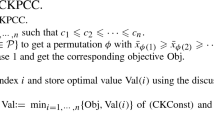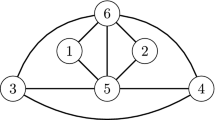Abstract
We study the convex hull of the continuous knapsack set which consists of a single inequality constraint with \(n\) non-negative integer and \(m\) non-negative bounded continuous variables. When \(n=1\), this set is a generalization of the single arc flow set studied by Magnanti et al. (Math Program 60:233–250, 1993). We first show that in any facet-defining inequality, the number of distinct non-zero coefficients of the continuous variables is bounded by \(2^n-n\). Our next result is to show that when \(n=2\), this upper bound is actually 1. This implies that when \(n=2\), the coefficients of the continuous variables in any facet-defining inequality are either 0 or 1 after scaling, and that all the facets can be obtained from facets of continuous knapsack sets with \(m=1\). The convex hull of the sets with \(n=2\) and \(m=1\) is then shown to be given by facets of either two-variable pure-integer knapsack sets or continuous knapsack sets with \(n=2\) and \(m=1\) in which the continuous variable is unbounded. The convex hull of these two sets has been completely described by Agra and Constantino (Discrete Optim 3:95–110, 2006). Finally we show (via an example) that when \(n=3\), the non-zero coefficients of the continuous variables can take different values.

Similar content being viewed by others
References
Atamtürk, A., Günlük, O.: Network design arc set with variable upper bounds. Networks 50, 17–28 (2007)
Agra, A., Constantino, M.F.: Description of 2-integer continuous knapsack polyhedra. Discrete Optim. 3, 95–110 (2006)
Jörg, M.: \(k\)-disjunctive cuts and cutting plane algorithms for general mixed integer linear programs. arXiv:0707.3945 (2007)
Atamtürk, A., Rajan, D.: On splittable and unsplittable flow capacitated network design arc-set polyhedra. Math. Program. 92, 315–333 (2002)
Di Summa, M., Wolsey, L.A.: Mixing sets linked by bidirected paths. SIAM J. Optim. 21, 1594–1613 (2011)
Magnanti, T.L., Mirchandani, P., Vachani, R.: The convex hull of two core capacitated network design polyhedra. Math. Program. 60, 233–250 (1993)
Magnanti, T.L., Mirchandani, P., Vachani, R.: Modeling and solving the two-facility capacitated network loading problem. Oper. Res. 43, 142–157 (1995)
Richard, J-Ph, de Farias Jr, I.R., Nemhauser, G.L.: Lifted inequalities for 0–1 mixed integer programming: basic theory and algorithms. Math. Program. B 98, 89–113 (2003)
Wolsey, L.A., Yaman, H.: The continuous knapsack set with divisible capacities. CORE Discussion Paper DP 2013/63, University of Louvain, Louvain-la-Neuve, Belgium (2013)
Yaman, H.: The splittable flow arc set with capacity and minimum load constraints. Oper. Res. Lett. 41, 556–558 (2013)




